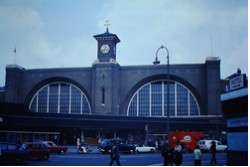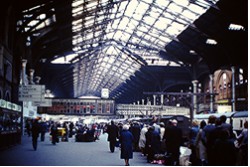Monopoly stations uk
There are four stations on any Monopoly board. On the UK board the stations are:
- Kings Cross Station
- Marylebone Station
- Fenchurch Street Station
- Liverpool Street Station
In the pre-war and wartime editions of Monopoly all of the stations are LNER (London and North Eastern Railway Company). This is marked on the cards, not on the board.
In the post-war game the cards are marked 'British Railways'.
The post-war version of the game also had a locomotive as a counter. It resembled the Mallard, LNER's record-breaking loco from the 1930s. It was also painted blue, the LNER livery. After the war the Mallard (the real one) was repainted in BR's dark green livery. I wonder if Waddingtons were not too keen on the nationalisation of the railways?

Kings Cross Station
On the Monopoly board King's Cross Station sits on the first quarter of the board amongst the cheapest properties. It is between 'Income Tax' and 'The Angel, Islington'. In reality, it is closer to Euston Road.
Lewis Cubitt designed the original King's Cross station. It opened on 14 October 1852. The operator was the Great Northern Railway (GNR).
When John Waddington marketed the London Monopoly game in 1936, the London and North Eastern Railway Company (LNER) operated King's Cross.
King's Cross was the London terminus for the East Coast Main Line. It was LNER's major route.
Marylebone Station
On the Monopoly board Marylebone Station is between Northumberland Avenue and Bow Street.
In reality, it is an hour's walk away from Northumberland Avenue and fifty minutes' walk from Bow Street.
Marylebone Station opened in 1899. It was originally the London terminus of the Great Central Railway Company (GCR). At the time the London Monopoly game was designed it was operated by LNER.
Fenchurch Street Station
On the Monopoly board Fenchurch Street Station is between Trafalgar Square and Leicester Square. In reality, both are about two miles away.
Fenchchurch Street Station is the oldest of the London Monopoly stations. It was opened in 1841 by the London and Blackwall Railway (L&BR). The railway was designed to provide access to the East and West India Docks. When it opened the railway did not use locomotives. The rolling stock was pulled along by a continuous wire rope. The rope was pulled by stationary steam engines. The system was abandoned in 1849. [1]
In the 1930s Fenchurch Street Station was the main station serving Southend and the London subuurbs along the way. Unlike the designation on the Monopoly card, it was operated by the London, Midland and Scottish Railway (LMS).

Liverpool Street Station
On the Monopoly board Liverpool Street Station is between Bond Street and Chance. Bond Street as it is on the Monopoly board is split into New and Old Bond Street. They are both three miles from Liverpool Street Station.
The station opened in 1874. It was operated by the Great Eastern Railway Company (GER). In the 1930s it was operated by LNER.
The station served the London suburbs in the 1930s. According to Harold Clunn, the line out of Liverpool Street Station was a 'tiresome bottleneck'. Unlike the competitor, Southern Railways (SR), LNER had not electified the line.[2]
Are the stations good buy?
If you a playing Monopoly and land on a station should you buy it?
All of the stations cost the same - £200. If you land on any of the stations and it is owned you will need to pay rent depending on how many stations the owner has.
- If one station is owned - £25
- If two stations are owned - £50
- If three stations are owned - £100
- If all four stations are owned - £200
The site only rent for one station is quite generous. Only Oxford Street, Regent Street, Bond Street, Park Lane and Mayfair have higher rents, but cost more to buy.
There are four squares on the Monopoly board and four stations. So if you own all four, there is 10% chance that one of your opponents could land on one of them at any time. Marlylebone Station is a good buy as there is a chance card which says 'Take a trip to Marylebone Station'.
All of the stations can be mortgaged for £100.
Unlike the properties, the stations they don't have as much scope for development. If you are lucky enough to get all four it will cost you £800. You will get a good return - around 100%.
But if you shunned the stations and bought properties you would always get a better return. The optimum is the light blue group - Euston Road, The Angel, Islington and Pentonville Road which will yield 160%. But the outlay to get a maximum return is greater.
The stations are a better buy than some of the more expensive properties because the outlay is lower. For example the green group - Oxford Street, Regent Street and Bond Street yield 100%, but the initial outlay is a whopping £3920.
So I would advise players to buy as many stations as they can. They yield results quickly and can provide funds to add houses and hotels to other groups.
References
[1] The Face of London, by Harold P Clunn, published by Simpkin Marshall 1932, Page 46
[2] The Face of London, by Harold P Clunn, published by Simpkin Marshall 1932, pages 36-7


Comments